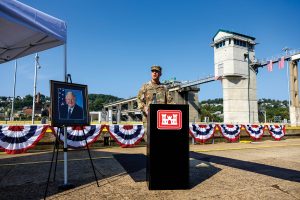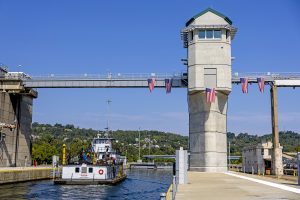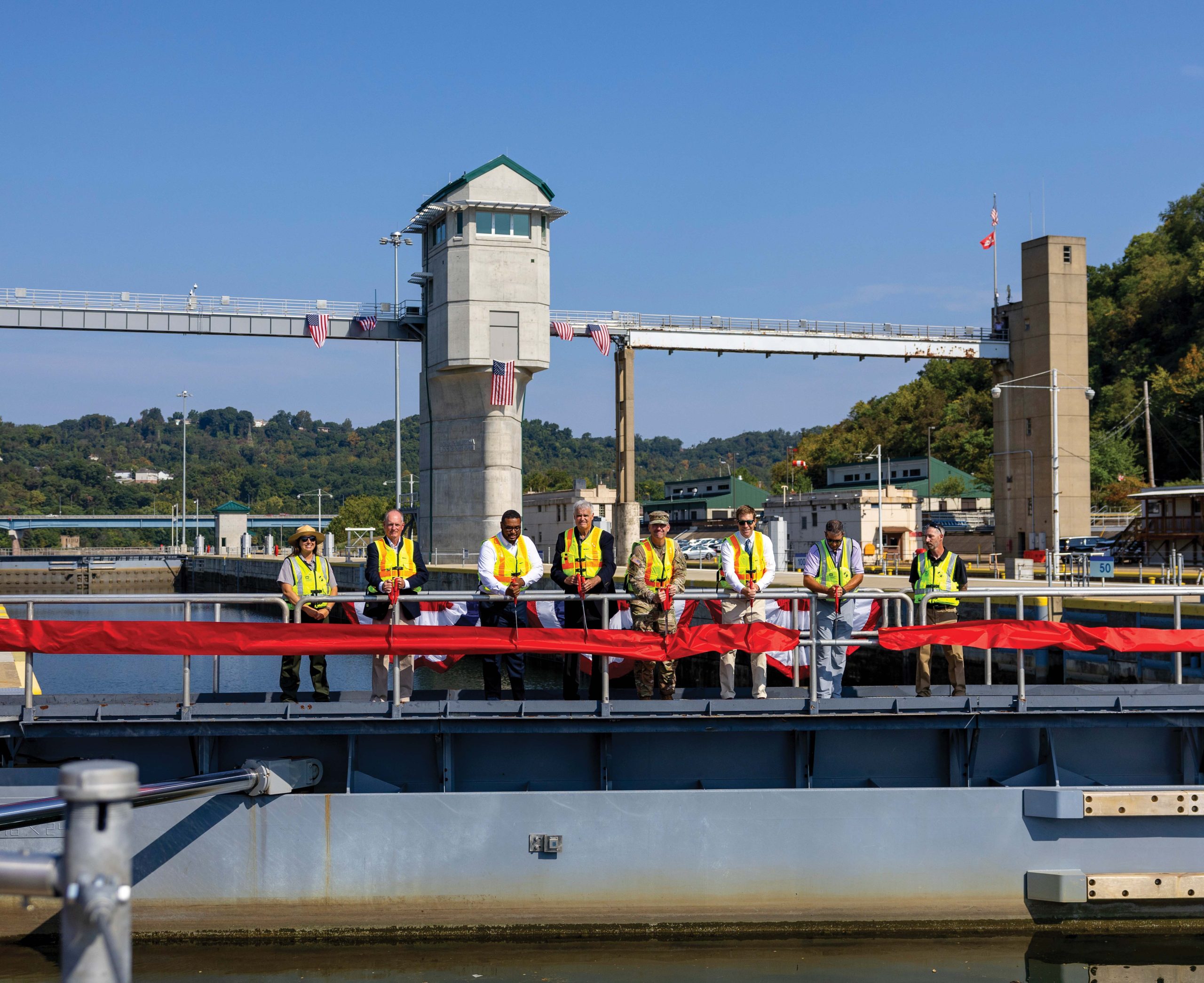After two decades of planning and construction, a ceremony August 28 marked the renaming and dedication of a new lock chamber on the Monongahela River near Charleroi, Pa.
Formerly Locks and Dam 4, the facility at Mile 41.5 has been renamed the John P. Murtha Locks and Dam in honor of the former Pennsylvania congressman and Marine veteran of the Vietnam War. Murtha represented Pennsylvania’s 12th Congressional district from 1974 until his death in 2010.
Pennsylvania Lt. Gov. Austin Davis and Col. Nicholas Melin, commander of the Pittsburgh Engineer District, spoke at the ceremony, which was emceed by Greg Turko, deputy operations chief for the Pittsburgh District.

“Today, we’re not merely renaming a facility,” Melin said. “We’re celebrating the culmination of decades of hard work by countless individuals. They braved long hours, late nights, harsh winters and sweltering summers to complete the U.S. Army Corps of Engineers’ newest and most advanced lock chamber—a monumental engineering achievement.”
He said the new lock will ensure reliable navigation on the Monongahela River for the next century and includes innovative technology “that paves the way for the potential remote operation of the lock in the future.”
Throughout construction, the navigation facility never had an unscheduled closure to industry, said Alan Nogy, the chief of the locks and dams branch for the district.
“We were available 24/7, 365 for the entirety of this project, which is not an easy undertaking when you think about what a big maintenance challenge that presents to keep a facility of this age operating,” he said.
In addition to Corps of Engineers employees and interested community members, the audience included John Murtha Jr., son of the late congressman.
“His impact stretches across the globe, but his heart was here, and he was always asking, ‘What more can I do to help?’” Murtha Jr. said. “My dad knew the three rivers were integral to western Pennsylvania’s economy, and he worked tirelessly to support and fund navigation improvements for the region. His years of effort and support opened countless opportunities for the Monongahela River.”
Davis said the network of 23 dams within the Pittsburgh District on the Ohio, Allegheny and Monongahela rivers saves shippers and consumers $4 billion on transportation costs compared to road and rails.
“Our steel mills helped build our country,” he said, later adding, “However, many folks don’t know the vital role our rivers provide to the nation’s economy.”
The crowd cheered and applauded as the mv. Georgetown of Campbell Transportation Company became the first vessel to pass through the newly dedicated facility.
The new riverside lock chamber at Charleroi was expanded to 720 feet long and 84 feet wide. Previously it was 360 feet long and 84 feet wide. Nine standard barges or six jumbo barges are able to lock through the expanded chamber at one time, while the old chamber could hold only six standard barges at a time, according to the district.
The previous lock chamber was built in 1931 and underwent a significant rehabilitation in 1963, but it was among the most antiquated in the system.
Construction on the new lock chamber began in 2004. A concrete batch plant on the Charleroi side of the river produced 165 yards of concrete per hour, the Pittsburgh District said. Contractors transported the concrete across the river using a specially designed conveyor system.
Over the course of 20 years, the new lock construction required 14 separate contracts, 250,000 cubic yards of concrete and 13 million pounds of reinforced steel for rebar. It also deepened the navigation channel by dredging 1.1 million cubic yards of soil from the riverway, the Pittsburgh District said. The chamber can hold more than 20 million gallons of water, equivalent to more than 30 Olympic-sized swimming pools.
Trumbull Corporation and Brayman were awarded the River Chamber Completion Contract at Charleroi in 2015 as a joint business venture, and the chamber was emptied in 2021 to complete the work. The chamber floor was completed in May 2023, along with all the operating equipment, the new control tower and control shelters. The chamber was filled last summer, with the new miter gates then set in place. Construction on the operating systems and the guidewalls that extend beyond the lock chamber was completed by the end of 2023. Fully integrated system tests on the new navigation chamber began in January, and the first commercial lockage was May 10.
The new lock at Charleroi is part of the $2.8 billion Lower Monongahela River Project, which was authorized in the Water Resources and Development Act of 1992. The project also included installation of a new gated dam at Braddock (Locks and Dam 2) and breaching Lock and Dam 3 at Elizabeth, Pa., to create a navigable pass, creating one 30.3-mile pool instead of 12.3-mile and 18-mile pools between the Braddock and Charleroi locks.
A 100-foot-wide navigation channel through the existing dam at Elizabeth was originally set to open near the end of the year, but the Corps announced an accelerated plan July 25 with an expected completion date of August 28. Melin told the crowd at the ceremony that the district expected the channel to open “within days.” Marine traffic has been limited to a 7-foot depth restriction in the former lock chamber at Elizabeth.
The landside lock chamber at Charleroi was decommissioned with the breaching of the dam at Elizabeth. With the new water levels, that chamber is no longer useable for navigation. The chamber will be made available for flushing debris or ice as conditions warrant, however. A future contract will include placing struts across the landside chamber’s downstream area and adding a stabilization berm to the downstream guidewall.

The Corps of Engineers determined it could capture 90 percent of the benefits of the project by expanding the riverside chamber and breaching the dam at Elizabeth without performing work to that chamber for now. Work to refurbish the chamber to allow navigation remains authorized by Congress, but the plan signed by the assistant secretary of the Army in 2014 defers work on the landside chamber until the 2050s.
The Corps of Engineers has estimated the Lower Mon Project will return more than $200 million in estimated annual benefits to the region and nation by saving maintenance and operations costs and transportation time.
Top photo caption: The Pittsburgh Engineer District celebrated completion of the newest lock chamber on Monongahela River during a renaming and dedication ceremony August 28. The former Locks and Dam 4 at Charleroi, Penn., is now the John P. Murtha Locks and Dam. (Photos by Michel Sauret/Pittsburgh Engineer District)




